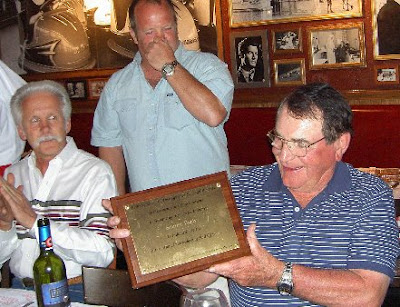
Gladstone, NJ - August 3, 2009 - The USET Foundation remembers today Seamus Brady of Whitehouse Station, NJ. Brady passed away on Monday, July 27, at the age of 77. Brady, who was born in County Cavin, Ireland, and trained at the Irish Army Equitation School in Dublin. He immigrated to the United States more than 50 years ago and became one of the most respected farriers in the world. Brady was the official farrier for the U.S. Equestrian Team for many years and was inducted into the International Horseshoeing Hall of Fame in 2002.
Seamus came to the United States and worked for USET Director Arthur McCashin at his Four Furlongs Farm in Pluckemin, NJ. Seamus was drafted into the U.S. Army, where he was a chauffeur to a general. His time in the Army gave Seamus the chance to learn more about welding and metalworking. Arthur’s son, Dr. Fred McCashin VMD, remembers, “When he came out (of the Army), he came back to see dad, who gave him some tools to start shoeing on his own. The rest is history.”
Seamus made a name for himself by working for some of the largest show barns in the country, by pioneering techniques, by teaching a number of up-and-coming farriers, and by being a consummate horseman.
Farrier Tom Ciannello apprenticed with Seamus in 1975, and they were close friends for the next three decades. “Shoeing was his life; it was the center of his life,” he stated. “If something ‘couldn’t be done,’ he would strive even harder to accomplish it. Seamus really put his heart and soul into every shoeing job. Our favorite saying was that you gotta love it, and he really did. He just really cared. That was one thing that he instilled in everybody that worked with him. Don’t worry about how long it takes, but just be proud of what you did. Everybody is going to miss him.”
In addition to his work with the USET, where Seamus was the team farrier for all three disciplines and was the team farrier at the 1988 Seoul Olympic Games, he was the farrier at a number of show barns, from Ronnie Mutch’s Nimrod Farm to the Leone family’s Ri-Arm Farm. He was also the farrier for George Morris’ Hunterdon Farm for 34 years. “He was a great asset to the USET and really part of the USET in a way. He was one of the pillars of Hunterdon,” said Morris, who is now the U.S. Show Jumping Chef d’Equipe. “He was famous as a great guy and a great friend. He was a very good friend of mine.”
Carol Hoffman Thompson rode for the USET from 1963 to 1973 and remembers Seamus as a “master of shoeing.” She noted, “He was the very best. He had a great sense of humor, and I had a lot of respect for him.”
Morris agreed, “He was a real old-fashioned Irish horseman. He was a horseman first. He was innovative, very imaginative. As he went along, he kept being innovative. I would often listen to him and after conferring with him and the vets, sometimes use his advice and opinion over the vets’. He was the guru teacher, and subsequent generations will owe him. He brought people in as working students, he shared with other blacksmiths, and in a sense, he is a father of American blacksmith technology. That goes across North America and to Europe too. He was one of the greats that I ever had anything to do with. I can’t say enough about him.”
Ciannello felt the same about Seamus as Morris. “People know him from all over. He was quite an ambassador for the USET and the horse business. Everybody wanted to talk to him, and he was just a really nice guy. If you knew Seamus and he knew you, and there was a mutual respect there, he was the best friend you could have.”
Surviving are his beloved children, son, Douglas Brady and wife, Loriann of Flemington, NJ; his daughters, Linda Colleen Deutsch and husband, Adam of Whitehouse Station, NJ, and Laura Jean Brady of Summerfield, NC; Ruth Moyer Brady, the cherished mother of his children; his beloved grandchildren, Casey Ann and Douglas Brian; eight brothers and sisters in Ireland; along with many other loving relatives and friends who will miss Seamus dearly.
Prayer Service for Seamus was held on Saturday, August 1, at the Branchburg Funeral Home, in Branchburg, NJ. For more information or to send condolences, please visit, BranchburgFuneralHome.com.
Photo Credit: Former USET official farrier Seamus Brady, 1932-2009. Photo courtesy of Maureen Pethick.







